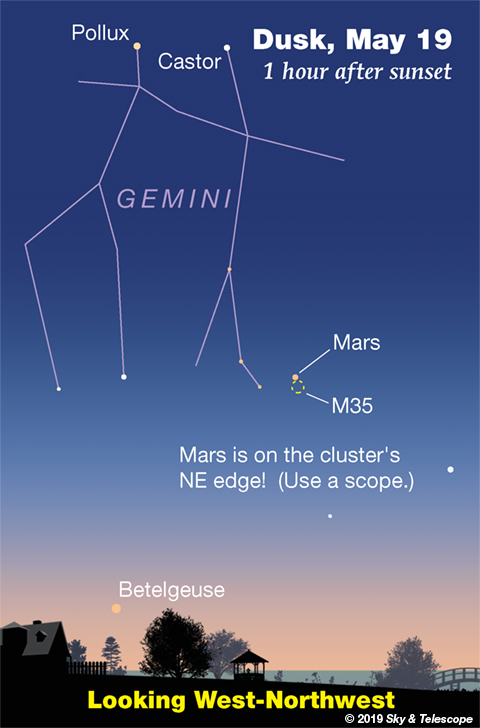
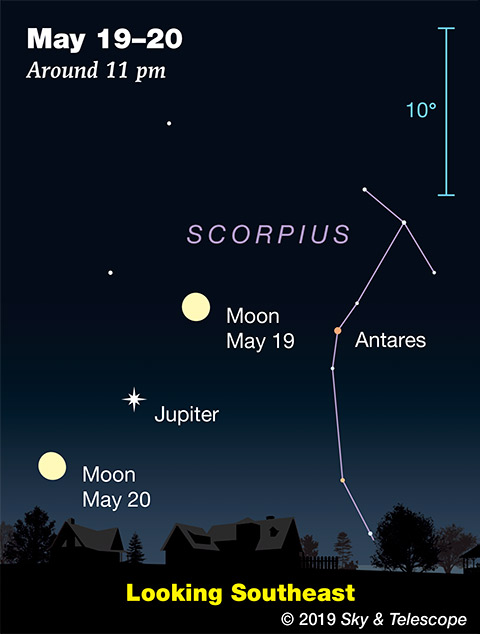
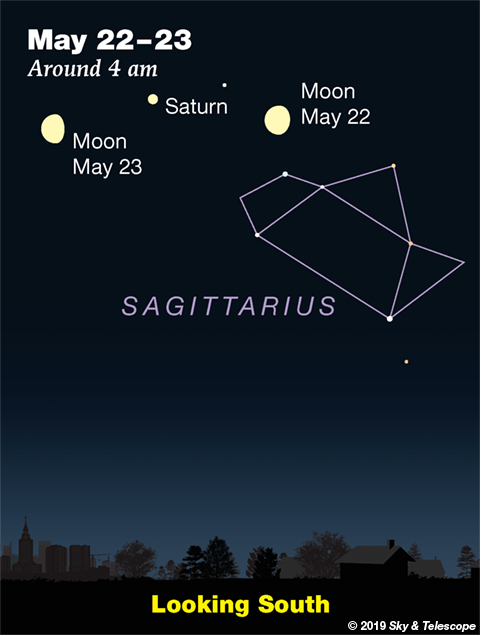
Friday, May 17
• The Moon, nearly full, shines in dim Libra. Binoculars will help you see through the moonlight to Beta Librae nearly 5° to the Moon's upper left (for North America), and Alpha Librae a similar distance to the Moon's lower right. Alpha is a nice binocular double star.
Stepping back for a much wider view, bright Arcturus shines very high above the Moon. Look less far to the Moon's right or upper right and there's Spica, one magnitude fainter.
Saturday, May 18
• Full Moon (exact at 5:11 p.m. Eastern Daylight Time). The Moon rises around sunset. After dark it hangs above the rising head of Scorpius, flooding it with moonlight. Can you see any stars of Scorpius at all? The brightest is orange Antares, about 10° below the Moon. Second brightest is Delta Scorpii, nearer the Moon.
Sunday, May 19
• The Moon, a day past full, forms a wide triangle with Jupiter to its lower left and Antares to its right in late evening, as shown here.
Monday, May 20
• The bright "star" upper right of the Moon late this evening is Jupiter. The giant planet is 40 times larger in diameter than the Moon but is currently 1,700 times farther away.
Tuesday, May 21
• This is the time of year when Leo the Lion starts walking downward toward the west, on his way to departing into the sunset in early summer. Right after dark, spot the brightest star fairly high in the west-southwest. That's Regulus, his forefoot.
Wednesday, May 22
• Vega is well up in the east-northeast after dark. Look for its faint little constellation Lyra, the Lyre, dangling down from it with its bottom canted to the right.
Thursday, May 23
• A gigantic asterism you may not know is the Diamond of Virgo, some 50° tall and extending over five constellations. It currently stands upright in the south after the stars come out. Start with Spica, its bottom. Upper left from Spica is bright Arcturus. Almost as far upper right from Arcturus (as you face south) is fainter Cor Caroli, 3rd magnitude, almost overhead. The same distance lower right from there is Denebola, the 2nd-magnitude tailtip of Leo. And then back to Spica.
The bottom three of these stars, the brightest, form a nearly perfect equilateral triangle. Maybe we should call this the "Spring Triangle" to parallel those of summer and winter?
In you have a dark sky or binoculars, look halfway from Cor Caroli to Denebola for the very large, sparse Coma Berenices star cluster. It spans some 4°, about the size of a ping-pong ball held at arm's length.
See Fred Schaaf's tour of this area in the May Sky & Telescope, page 45.
Friday, May 24
• Meanwhile the Summer Triangle is making its appearance in the east, one star after another. The first in view as night descends is Vega, the brightest star in the east-northeast. Lower left it (by two or three fists at arm's length) is Deneb. Farther to Vega's lower right is Altair, rising above the horizon not long after dark.
Saturday, May 25
• Have you ever seen Alpha Centauri?! At declination –61° it's permanently out of sight if you're north of latitude 29°. But if you're at the latitude of San Antonio, Orlando, or points south, Alpha Cen skims just above your true southern horizon for a little while late these evenings.
When does this happen? Just about when Alpha Librae, the lower-right of Libra's two brightest stars, is due south over your landscape. At that time, look straight down from there!
________________________
Want to become a better astronomer? Learn your way around the constellations. They're the key to locating everything fainter and deeper to hunt with binoculars or a telescope.
This is an outdoor nature hobby. For an easy-to-use constellation guide covering the whole evening sky, use the big monthly map in the center of each issue of Sky & Telescope, the essential guide to astronomy.

Once you get a telescope, to put it to good use you'll need a detailed, large-scale sky atlas (set of charts). The basic standard is the Pocket Sky Atlas (in either the original or Jumbo Edition), which shows stars to magnitude 7.6.
Next up is the larger and deeper Sky Atlas 2000.0, plotting stars to magnitude 8.5; nearly three times as many. The next up, once you know your way around, are the even larger Interstellarum atlas (stars to magnitude 9.5) and Uranometria 2000.0 (stars to magnitude 9.75). And read how to use sky charts with a telescope.
You'll also want a good deep-sky guidebook, such as Sue French's Deep-Sky Wonders collection (which includes its own charts), Sky Atlas 2000.0 Companion by Strong and Sinnott, or the bigger Night Sky Observer's Guide by Kepple and Sanner.
Can a computerized telescope replace charts? Not for beginners, I don't think, and not on mounts and tripods that are less than top-quality mechanically (meaning heavy and expensive). And as Terence Dickinson and Alan Dyer say in their Backyard Astronomer's Guide, "A full appreciation of the universe cannot come without developing the skills to find things in the sky and understanding how the sky works. This knowledge comes only by spending time under the stars with star maps in hand."
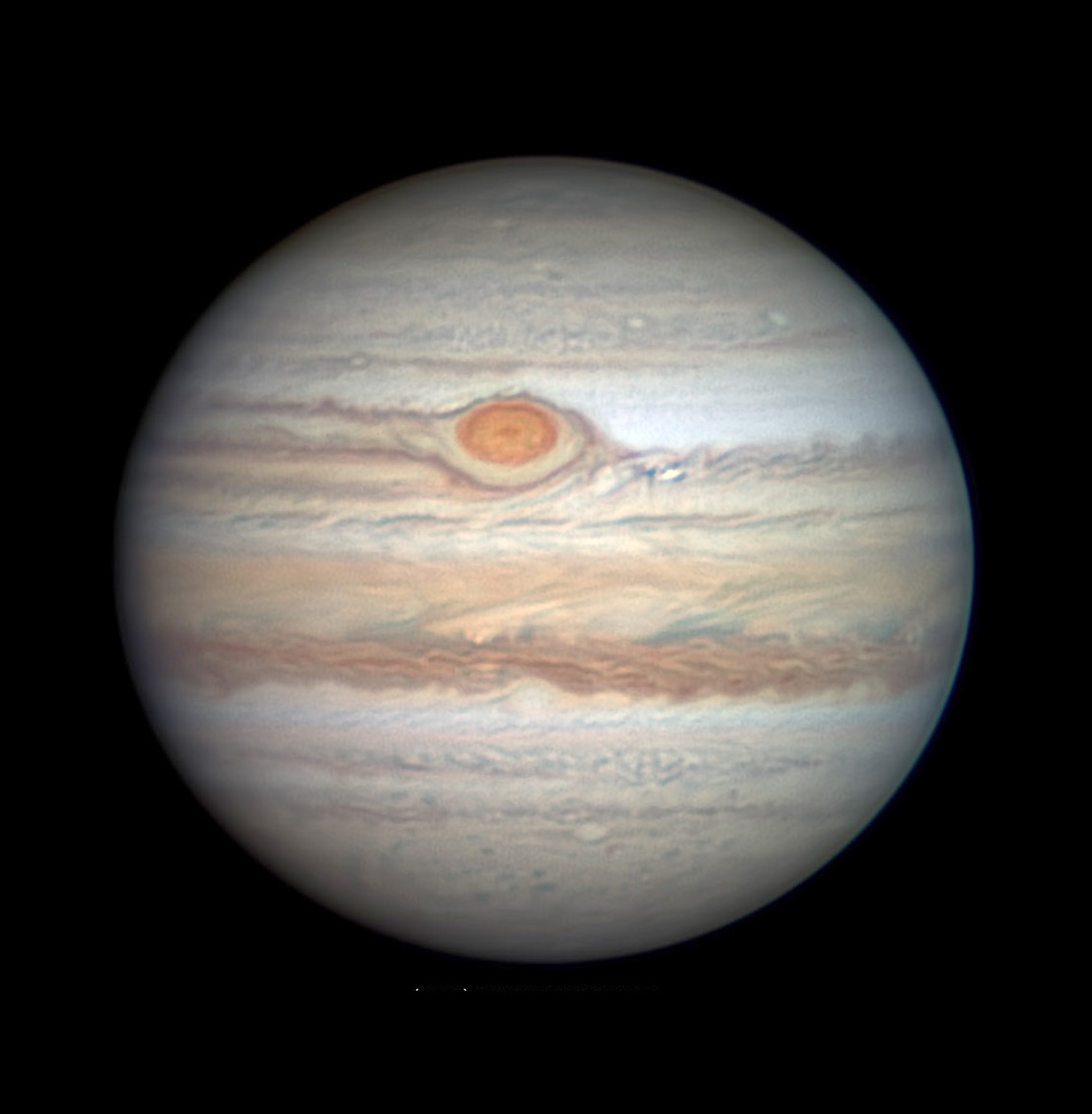
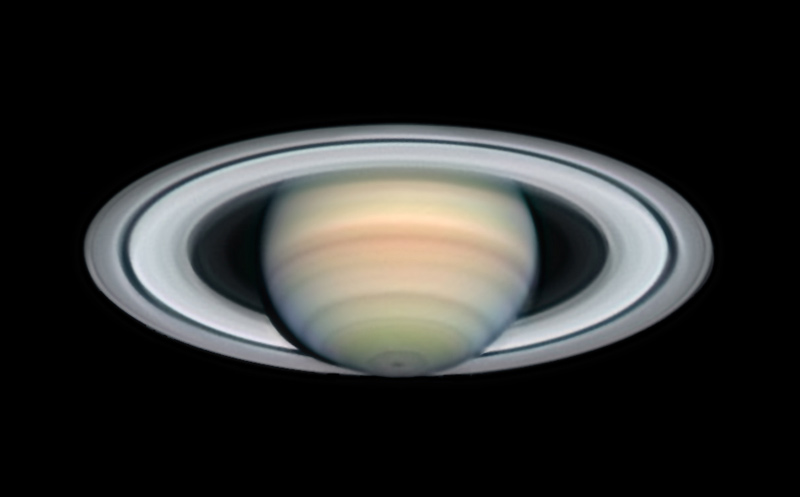
Mercury is hidden in conjunction with the Sun.
Venus (magnitude –3.8) is very low in bright dawn. Just 15 or 20 minutes before sunrise, scan for it with binoculars just above the east horizon.
Mars (magnitude +1.7) is low in the west during and shortly after dusk, to the right of the feet of Gemini. Look for it far below or lower right of Castor and Pollux.
Don't confuse Mars with similarly faint Gamma Geminorum (Alhena) off to its left, or much brighter Procyon farther to the left.
Jupiter (magnitude –2.5, in the eastern leg of Ophiuchus) rises in the southeast in late twilight. It shines highest in the south around 2 or 3 a.m., with orange Antares twinkling 13° to its lower right.
In a telescope Jupiter has grown to 45 arcseconds wide as it approaches its June 10th opposition. Big changes have started happening in and around Jupiter's Great Red Spot. See caption above.
Saturn (magnitude +0.4, in Sagittarius) rises around midnight. Before the beginning of dawn, it's the steady, pale yellowish "star" 28° (about three fists at arm's length) left of Jupiter.
Uranus is hidden deep in the glow of dawn.
Neptune (magnitude 7.9) is still low in the east-southeast before dawn begins. Wait a couple months.
______________________
All descriptions that relate to your horizon — including the words up, down, right, and left — are written for the world's mid-northern latitudes. Descriptions that also depend on longitude (mainly Moon positions) are for North America.
Eastern Daylight Time (EDT) is Universal Time (UT, UTC, GMT, or Z time) minus 4 hours.
______________________
Audio sky tour. Out under the evening sky with your earbuds in place, listen to Kelly Beatty's monthly podcast tour of the heavens above. It's free.
______________________
“This adventure is made possible by generations of searchers strictly adhering to a simple set of rules. Test ideas by experiments and observations. Build on those ideas that pass the test. Reject the ones that fail. Follow the evidence wherever it leads, and question everything. Accept these terms, and the cosmos is yours.”
— Neil deGrasse Tyson, 2014
______________________
 3
3








Comments
Rod
May 22, 2019 at 10:50 am
mary beth, any stargazing reports? I was out last night and early this morning, 11:40 PM to 01:15 AM. Jupiter and the Great Red Spot transiting was the show I enjoyed using my telescope. The Great Red Spot moved across from its position and towards the central meridian of Jupiter near 0100 EDT. The waning gibbous Moon rose in Sagittarius in SE sky, casting ethereal moonlight all around me when its altitude high enough above the tree line of the woods. I used a green planetary filter while viewing Jupiter and the Great Red Spot, and later I looked at the Moon too. It sure looked like green cheese near the Tycho crater and Atlas crater area near the terminator line. Perhaps at a star party viewing the Moon, I could pull a prank and tell folks-the Moon is made out of green cheese, just take a close look in the eyepiece 🙂
You must be logged in to post a comment.
mary beth
May 23, 2019 at 12:16 am
Haha.... I bet people would fall for it LOL! Truly what is the purpose of the green filter? Does it just make things more clear and ease the brightness?
We’ve had a few good clear night and the moon is so pretty but unfortunately the night of the full moon it was cloudY. Vega has been fun to watch and I can still see Sirius. Really looking forward to see in Scorpius with Jupiter and I believe Saturn fairly close? The southern sky is going to be so lovely!
I don’t know if it’s my imagination or whether there is something to it but are used to see the northern crown much clearer than I do now. Maybe they’re just more pollution but I feel like I can’t make out the stars like I used to. I think during our lifetime one of the stars in the head of Scorpio has gotten brighter...Kind of interesting that it is noticeably brighter!
I hope all of you have a wonderful memorial day holiday! You’ll have to let me know if anyone fell for your prank!
You must be logged in to post a comment.
Rod
May 23, 2019 at 7:44 am
mary beth, you asked "Truly what is the purpose of the green filter? Does it just make things more clear and ease the brightness?" Yes, planetary filters for the eyepieces help reduce glare and brightness, especially on planets like Jupiter and Venus and enhance different features visible, like on Mars. The green filter helped enhance the cloud bands on Jupiter, making them easier to see and darkens the Great Red Spot, making it easier to observe and see its oval shape. I viewed at 129x using my 90-mm refractor and watched the GRS for 1.5 hours or more, slowly move towards the central meridian as predicted. I also use a Moon filter and two, polarizing filters sometimes. You and your family enjoy Memorial Day weekend too. Weather looks good here for Friday night, perhaps I may use my 10-inch telescope to look at M101, reference Bob King's report.
You must be logged in to post a comment.
You must be logged in to post a comment.